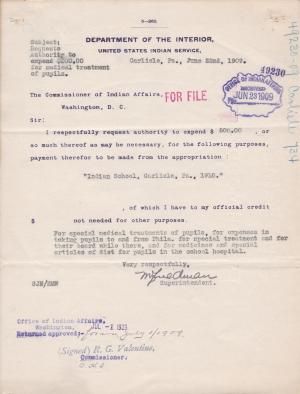Carlisle Indian School Superintendent Moses Friedman requests to spend $500 from the "Indian School, Carlisle, Pa., 1910" account for special medical treatment of students, to send students to Philadelphia for treatment, and for medicine and food for the school hospital. Commissioner of Indian Affairs R. G . Valentine approves Friedman's request.
Chief Clerk C. F. Hauke tells Friedman to have his physician prepare a report detailing the effectiveness of open air treatment for tuberculosis at the school. Friedman sends a list of students who received the treatment and their status, ranging from "no improvement - death" to "greatly improved."
Hauke asks Friedman to clarify if any of those cases were "tubercular" and/or if "tubercle bacilli" were found in the sputum and if Ernest Iron's death was due to tuberculosis. Friedman informs the Commissioner of Indian Affairs that Irons' death was due to tubercular meningitis, but their hospital records don't provide that sort of information on the students who survived. Friedman forwards Hauke's question to former school physician Dr. F. Shoemaker, who's now at the Crow Agency.
Shoemaker provides a report to Friedman giving the students' name, diagnosis, presence of bacilli in sputum, and status of tuberculin test. Shoemaker also states that his rule was to send students home if the tuberculosis had progressed to the point of showing bacilli in the sputum. Friedman forwards Shoemaker's letter to the Commissioner. The overall results of the report show that of 26 students treated by the open-air method, 21 improved, 4 did not improve, and 1 died.

